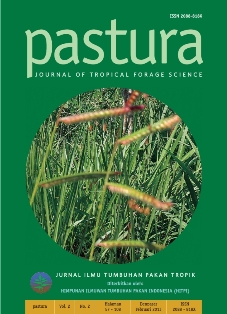ANALISIS USAHATANI TERPADU TANAMAN DAN TERNAK KAMBING DI AREAL PERKEBUNAN KELAPA DI SULAWESI UTARA
Abstract
Coconut Commodity as a source of income many people in North Sulawesi. The area of 266,147.36 ha of coconut plantation largely cultivated in monoculture. Under these conditions it is necessary to empower that coconut farming remains a mainstay source of income for the family farm. Objective of the assessment that has been done is to analyze the integrated plant and goat farming in the area of coconut plantation. The rationale, the lower the productivity of coconut. In the 2003 - 2004 has made the development of goats in the plantation area in KP Pandu village Talawaan Bantik Wori District of North Minahasa. Development is done using a model of integrated farming of coconut, corn and goats. One hectare of coconut land area fenced with Gliricidia produced 843.2 kg of fresh forage /90 day. 0.2 ha of land planted with king grass has produced fresh forage 9,150kg/45 day. 0.6 ha of land planted with corn yield 2,829.6 kg and 8,787 kg of straw hay. Compiling the ability to produce forage of three forage sources can meet the needs of 90 goats. Compiling the ability to produce forage of three forage sources can meet the needs of 90 goats. An increase in profits of Rp 634,650/year/ha in monoculture to Rp 14,262,070/year/ha in integrated farming. In conclusion, in order to increase productivity and farm income coconut diversification should do both vertical and horizontal. How to apply the integrated farming systems integration goat corn coconut (SIKJK).Downloads
Download data is not yet available.
How to Cite
POLAKITAN, Derek.
ANALISIS USAHATANI TERPADU TANAMAN DAN TERNAK KAMBING DI AREAL PERKEBUNAN KELAPA DI SULAWESI UTARA.
Pastura, [S.l.], v. 2, n. 2, june 2014.
ISSN 2549-8444.
Available at: <https://ojs.unud.ac.id/index.php/pastura/article/view/9023>. Date accessed: 03 jan. 2026.
doi: https://doi.org/10.24843/Pastura.2013.v02.i02.p04.
Issue
Section
Articles
Keywords
coconut plantation, corn, forage, goats





